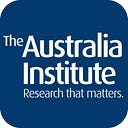Personal income tax cuts — How does your electorate fare?
The Australia Institute has completed an electorate-by-electorate analysis of the governments proposed income tax cuts. Here’s what our research shows:
1 / The biggest winners are all wealthy inner city electorates in Melbourne and Sydney. The losers are spread across the country.
City electorates would receive on average 112 cents for every dollar received by the average family, while regional electorates would receive only 87 cents for every dollar.
2 / The Prime Minister’s own seat of Wentworth are the biggest winners: receiving almost double the national average benefit.
And, the top 10 electorates all get at least one and a half times more than the national average. This is a tax cut that truly delivers for the top-end and leaves everyone else behind.
How the Top 10 electorates fare:
3 / NSW is not only home to the highest benefiting electorate, it’s also home to the lowest.
Only a stones throw away from the Prime Minister’s electorate, is the electorate of Blaxland. Ranked lowest of all 150 Federal electorates, Blaxland only receives 70 cents for every dollar received on average.
How NSW electorates fare:
4 / In Victoria, it’s clear that regional areas miss out.
Wealthy inner city electorates like Melbourne Ports, Higgins and Kooyong, are amongst those to benefit most in the state. The losers are spread across electorates like Gippsland and Ballarat- regional electorates.
How Victorian electorates fare:
5 / South Australians are some of the biggest losers from these income tax cuts.
Stunningly, two of South Australia’s 11 electorates — Wakefield and Port Adelaide — fall into the national bottom 10 electorates across the country.
How South Australian electorates fare:
And it’s no surprise that electorates like Mayo in SA rank so poorly. This tax cut is highly selective, so even though Mayo encompasses the relatively affluent Adelaide Hills, the electorate also covers regional areas, which is where we are seeing the least benefits across the country.
In fact, South Australians on average only receive 90% of the national average benefit.
6 / Tasmania as a whole benefits the least of any state in Australia
Average benefits for the Tasmania as a whole show families in the state would only receive 80 cents on average for every dollar received by families living in mainland states and electorates.
It is also the only state without a single electorate that receives even the national average.
How Tasmanian electorates fare:
On top of that, the electorates of Braddon and Lyons rank third and fourth last among all electorates in Australia.
7 / No surprise: Julie Bishop’s electorate tops Western Australia
It’s no surprise that Julie Bishop’s own electorate of Curtin tops the Western Australia table.
Curtin, Perth and Stirling all receiving well above the benefit received by the average household.
On the surface, it appears WA receives the biggest benefit on average, compared to other states, however, the total for WA is inflated because two of the electorates that are likely to lower the average (O’Connor and Durack) did not pass NATSEM’s validation test, so could not be included in the analysis.
How Western Australian electorates fare:
8 / ACT electorates above average, but neither federal electorate makes the national top ten.
Both Federal electorates in the ACT receive well above average benefits from income tax cuts but neither make the top 10. The electorate of Fenner receiving 128 cents for every dollar and the electorate of Canberra getting 140 cents.
How ACT electorates fare:
9 / The government’s income tax bill should be split or amended.
Our research shows it is the benefits of the top-end tax cuts — stage 2 & 3 of the government’s income tax plan — that flow so overwhelming to the wealthiest electorates.
They should be blocked in the Senate, add your name to the petition > http://theaus.in/topendtaxcut
From all of the team at The Australia Institute, thanks for reading.
We are able to do what we do because of your support.
Subscribe to our mailing list to receive updates like this, straight to your inbox.
* Source: Australia Institute calculations; Analysis from NATSEM’s STINMOD+ Tax/Transfer model and SpatialMSM18 spatial microsimulation model.
Electorates in WA and NT that have been excluded from this analysis, did not pass NATSEM’s validation testing.
